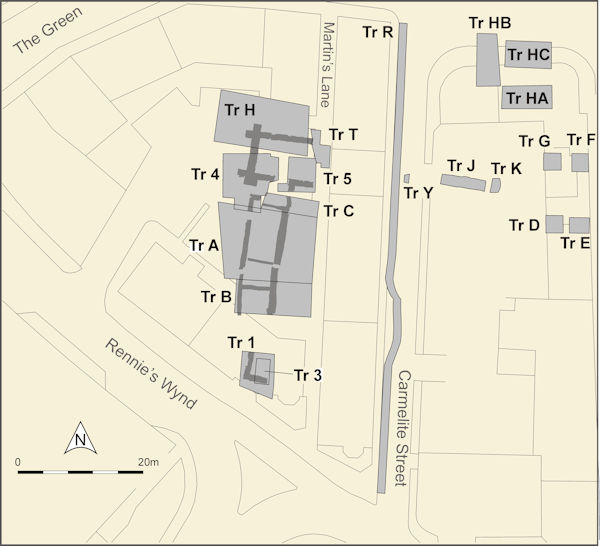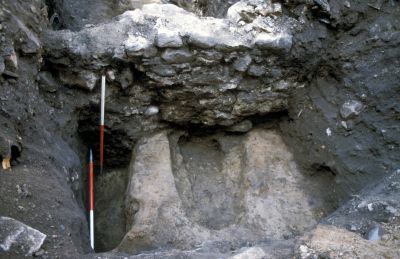



This excavation took place in several phases, the main periods being over the winter of 1980-1 and the spring and summer of 1994 [Photo 0036]. Three trenches (1994: A, B and C: see Trench location plan) were excavated between the two series of trenches opened in 1980-1 with the aim of further investigating the buildings that were partially excavated at that date. It was not possible, however, to join the 1994 trenches to 1980-1 (Trench 1 and Trench 3). Trenches D-G were sunk in a basement in Carmelite Lane to determine the survival of archaeological remains below the basement floors in that street. The water table was quickly discovered in these trenches and as a result no archaeological remains were found. These trenches appear on the site plan but are not mentioned again in this report. Burials were first located in 1980-1 in a machine trench [Photo 0117] and these burials were excavated, but it has not been possible to tie these in to the skeletons excavated during the main part of that excavation. The machine trench is therefore not mentioned again in this report either except for the detailed descriptions of SK1-16.

Trench H joined with the north edge of the 1980-1 Trenches 4 and 5 and extended north and west of the position of the building thought to be the church. Trenches J and K were barely 1.5m wide and ran from Carmelite Lane east along the line of a main sewer route through the graveyard area. An area to the east of Carmelite Street, thought to be the possible location of the graveyard of the friary, was also excavated. Deep foundations of 19th-century warehouses [Photo 0394] had disturbed some of the area, although a number of bones [Photo 0141] recovered from the foundation trenches of one of these walls indicates that these represented skeletons reburied during the construction of this warehouse. Contemporary newspaper reports indicate that much human bone was found during 19th-century building and road works in this area.


Three trenches at 19-25 Hadden Street (Trenches HA, HB and HC, called 'graveyard') (Stones 1989, 49-50) revealed garden soil which contained very decayed human bones representing portions of four fragmentary individuals, three children and an adult. That evidence indicates that this area was probably outwith the graveyard, but still within the precinct of the friary during the medieval period. It was not possible to join this trench with the main excavations, but dating evidence suggests that burials were taking place in this area during or soon after the construction of the church. Trenches L-Y [Photo 0127] were monitored in Carmelite Street and Martin's Lane during sewer replacement (not illustrated here).

Because most of the trenches were not joined, and they were not all open at the same time, it was not possible to produce a definitive phase list for all the layers and features found in them. Instead, general composite phases have been created which are intended to show features and events that are broadly synchronous. Coins were used to date a small number of contexts, but the main dating evidence was the small assemblage of pottery, while construction of the church can be dated by the worked stone.
Layers and features were not numbered sequentially over the two excavations, and therefore they have been renumbered for this publication. The layer and feature numbers relating to the 1980-1 excavation are prefixed with a J (e.g. JAA, J105) and the 1994 with an A (e.g. AAA, A105). A small number of skeletons and other features are not included on the plans but are still included in the datasets.
Internet Archaeology is an open access journal based in the Department of Archaeology, University of York. Except where otherwise noted, content from this work may be used under the terms of the Creative Commons Attribution 3.0 (CC BY) Unported licence, which permits unrestricted use, distribution, and reproduction in any medium, provided that attribution to the author(s), the title of the work, the Internet Archaeology journal and the relevant URL/DOI are given.
Terms and Conditions | Legal Statements | Privacy Policy | Cookies Policy | Citing Internet Archaeology
Internet Archaeology content is preserved for the long term with the Archaeology Data Service. Help sustain and support open access publication by donating to our Open Access Archaeology Fund.